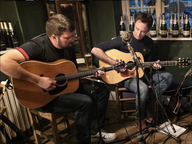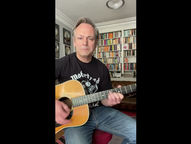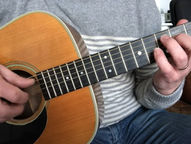1974 Martin D-28, as made famous by Jimmy Page
Such an iconic guitar, it's really as made famous by 100s of guitar gods. But Jimmy Page gets the laurels here. A D-28, "Going To California", and Led Zeppelin's 5-date run at Earl's Court in 1975. Legendary!
First produced under the Martin brand in 1931, D-model guitars were not an instant hit. Far from it. Guitarists of the day were used to smaller builds and didn't take to these big-bodied beauties. Sales were slow. Until, that is, Martin had their eureka moment. "Let's make a virtue of the big bass response, and advertise it as a bass guitar". Not the bass guitar we know today, but something that could fill in the bass range of a country music group, instead of the more traditional (and heavy and bulky) double bass. First nail in the coffin from Martin, second and deeper nail from Fender in 1951 with the launch of the Precision Bass.
The marketing strategy worked, and sales built rapidly. It may have been country music that launched the love for the D-models, but if you want to go global, make sure your D-28's there at the birth of Rock N Roll, in the hands of The King (or at least soon-to-be-king). That first Elvis Presley album, fluorescent print, black and white live shot, Martin D-28 in hand. The dream and the inspiration for generations of musicians to follow. Johnny Marr captures the thought a lot better, writing about his 1971 Martin D-28 in Marr's Guitars: "I could only dream of owning a guitar like this when I was a kid." Every guitar god starts as a dreamer.
This one could equally make it into the As Played By halls of fame. Bought from Mike Aungier, son of 60s folk singer-songwriter Cliff Aungier, it's definitely one he's played, if not performed live with. Whatever the provenance, this D-28 has earned its place among the iconic line-up of Martin's most famous guitars. Big on tone, with a cracking bass response, this is a truly fabulous guitar to play. Needs to be seen, played and heard to be believed - no trip to California required.
See & Hear It In Action
-
Going To California, 1975: In full, from Led Zeppelin IV to a 5-night residency at London's Earl's Court, Jimmy Page close to being outplayed by John Paul Jones on the mandolin . . . close, but not quite.
-
A(n Almost) Stock 1974 D-28: Master Luthier Bryan Kimsey plays and talks through his modifications (read improvements!) to this 1974 model - "a slightly modified guitar that does play in tune". He wasn't going to go for a split saddle . . . he moved the bridge back 1/8".

Feedback
Specification
Make
Martin
Model
D-28
Colour
Natural
Year
1974
Serial Number
336439
Number of Frets
20
Fretboard
Ebony, unbound
Neck
Mahogany
Body
Sitka Spruce & Indian Rosewood
Tuners
Grover Rotomatics
Bridge
Belly Bridge, Split Saddle
Scale Length
25.40"
Full Length
40.375"
Further Information:
-
Dinner-table trivia: The "D" stands for "Dreadnought", named in recognition of the enormous Dreadnought battleships that cruised the planet's oceans in the early 20th century and through World War I. And, less of a wow factor, the "28" indicates the style of the guitar. In this case: Spruce top, rosewood back and sides, multi-ply binding with a white outer layer, ebony fretboard and bridge, dot inlays, a back stripe, and 5/9/5 grouping of soundhole rings.
-
All of which this one has. To be fair, though, it's not perfectly original. The quality Martin were and are rightly famed for took a slight downturn in the 70s. And that probably accounts for the two most unique features of this 1974 D-28:
-
A split saddle. Research as much as I can, I can't find any examples of an original Martin acoustic with a split saddle. But I have read that the intonation on the 70s models wasn't always perfect - see the Bryan Kimsey video above, where he's gone to the extent of moving the bridge back 1/8". A popular mod in the 70s, to correct Top E and B-string intonation, my guess is that this is an example of that popularity. It's been done perfectly, and you wouldn't know it's not original, but until I find an original with a split-saddle, then mod it is.
-
A new pickguard. Martin introduced the black plastic pickguard onto their acoustics in 1967. They glued this directly onto the body. Which meant that if there was any shrinkage in the pickguard, it could crack (and, worse, crack the body top wood it was glued to). No signs of body-cracking here, but definitely signs of a non-professional replacement.
-
Neither of which affects the tone and response of this great guitar. In fact, the split saddle probably improves the intonation (or why change it?). This is a guitar to fall in love with. Unique sound across the range, big and bold, playing proudly among the ranks of Martin's most popular guitars.
Sources & Links
-
Martin Catalogue: 1972 - 1974: With thanks to the exhaustive curatorship of Doug Schmude, who set up this site solely for the archive of Martin Catalogues. Turn to page 4 to see the D-28: "a work of experience and excellence".
-
A Short History of The Martin D-28: Nice three-minute read, a lovely blog courtesy of Thalia Capos.
-
An All You Can Eat History and Spec Compendium Absolutely invaluable, once again Guitar HQ comes up trumps with all the questions you could think of (and those you can't) covered.
-
Cliff Aungier Bio: In tribute to the previous owner's father, folk singer-songwriter Cliff Aungier. A full-circle moment, with Jimmy Page producing Cliff's 1965 collaboration with Royd Rivers, Wanderin'.




































